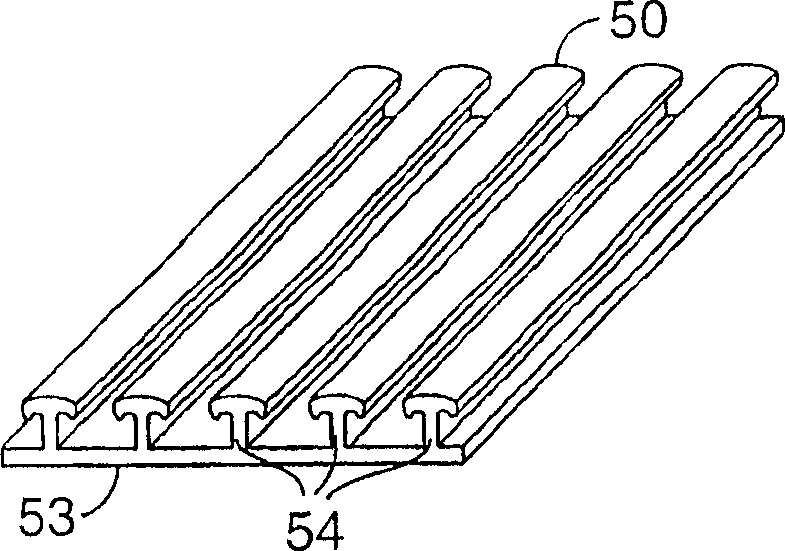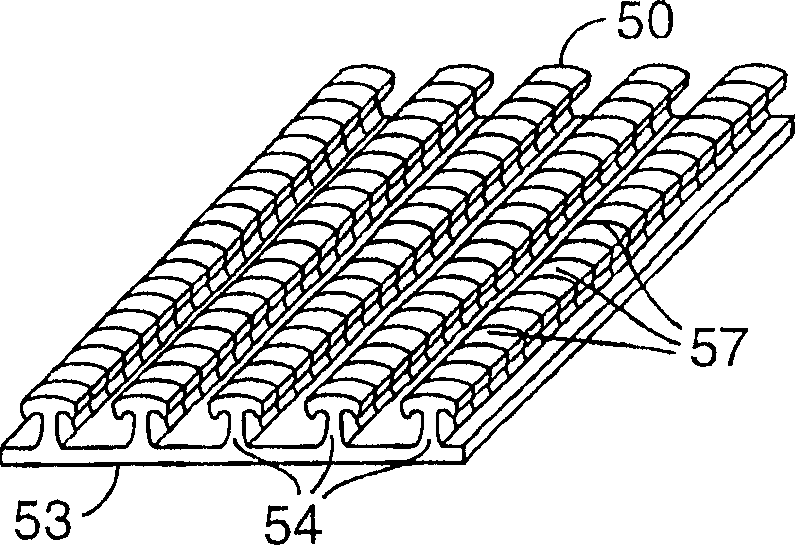Heat treated profile extruded hook
A technology of granular fillers and thermoplastic resins, applied in apparel, applications, fasteners, etc., can solve problems such as difficult productivity and narrow hook structure
- Summary
- Abstract
- Description
- Claims
- Application Information
AI Technical Summary
Problems solved by technology
Method used
Image
Examples
Embodiment 1
[0092] The web of Comparative Example C1 was subjected to the hook side on its side by conveying the web under a 36 cm wide ribbon flame burner Aerogen (Alton Hampshire, UK) at a speed of 90 m / min and at a distance of 8 mm from the burner. Non-contact heat treatment. The flame power is 74KJ / hour. The smooth base film side of the web was supported on chilled rolls at a temperature of about 18°C. Figure 6a and 6b An approximate outline of such a heat-treated hook is shown in . The performance of this hook material on nonwoven loop material 'A' was tested using a 135 degree peel test and the results are set forth in Table 1 below. The peel force of the heat-treated web was about 63% greater than that of Comparative Example C1 without heat treatment.
Embodiment 2
[0094] The web of Comparative Example C1 was subjected to non-contact heat treatment on its hooked side by conveying the web under a bank of 6-1000 watt, 1 micron wavelength infrared bulbs at a speed of 2.1 m / min. The distance between the hook and the bulb is about 2.5cm. The smooth base film side of the web was supported on chilled rolls at a temperature of approximately 66°C. Figure 7a and 7b An approximate outline of such a heat-treated hook is shown in . The performance of this hook material on nonwoven loop material 'A' was tested using a peel test and the results are given in Table 1 below. The 135° peel force of the heat-treated web was approximately 206% greater than that of Comparative Example C1 without heat treatment.
Embodiment 3
[0098] The web of Comparative Example C2 was subjected to non-contact heat treatment on its hooked side by conveying the web under a bank of 6-2000 watt, 1 micron wavelength infrared bulbs at a speed of 3.0 m / min. The distance between the hook and the light bulb is about 1.6cm. The smooth base film side of the web was supported on chilled rolls at a temperature of approximately 66°C. The performance of this hook material on nonwoven loop material 'A' was tested using a peel test and the results are given in Table 1 below. The 135° peel force of the heat-treated web was about 37% greater than that of Comparative Example C2 without heat treatment.
PUM
 Login to View More
Login to View More Abstract
Description
Claims
Application Information
 Login to View More
Login to View More - R&D
- Intellectual Property
- Life Sciences
- Materials
- Tech Scout
- Unparalleled Data Quality
- Higher Quality Content
- 60% Fewer Hallucinations
Browse by: Latest US Patents, China's latest patents, Technical Efficacy Thesaurus, Application Domain, Technology Topic, Popular Technical Reports.
© 2025 PatSnap. All rights reserved.Legal|Privacy policy|Modern Slavery Act Transparency Statement|Sitemap|About US| Contact US: help@patsnap.com



